Primary navigation
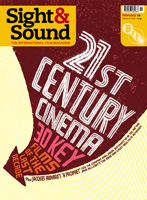
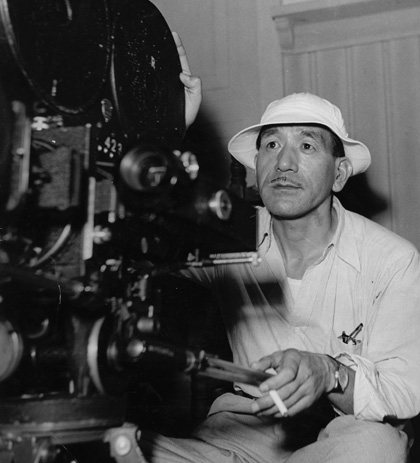
Ozu is often perceived to be a uniquely Japanese director with a fascination for the domestic, but in fact he was a wide-ranging movie fan who started out aping US films and rarely had real experiences to parallel the lives of his protagonists. By Tony Rayns
The Japanese director Ozu Yasujiro is best-known both at home and abroad for his post-war films. Almost all of them are family dramas, centred on relationships – often troubled or contentious – between parents and young or grown-up children. Many hinge on questions of marriage, generational misunderstandings and the loneliness of the elderly. They vary in tone from the broadly comic to the broadly sombre, but are enough alike in theme, style and in their idiosyncratic film grammar to have given rise to the adjective ‘Ozu-esque’. In one of his most famous interview quotes, Ozu likened himself to a maker of tofu: “I just want to make a tray of good tofu. If people want something else, they should go to the restaurants and shops.” But when film historians began to re-examine Ozu’s pre-war work (a process that didn’t really get started until the 1970s, since which time several early ‘lost’ films have turned up), they discovered that Ozu’s tofu recipes were more varied than previously imagined. Few knew that the director of films like Tokyo Story (1953) and Early Spring (1956) had once made riotous student-slacker comedies and gangster movies.
The post-war films were not seen outside Japan until well after the western ‘discovery’ of Kurosawa, Mizoguchi and one or two other directors. When some of the 1950s films did finally reach international distribution, subtitles naturally limited their play to art houses; they were seen and to some degree understood as art films. In Japan, critics had been recognising Ozu’s talents since 1930, the year his films began to appear in the annual ‘Best Ten’ critics’ poll organised by the magazine Kinema Junpo; the Japanese, like the French, took the ‘pop’ art of cinema seriously long before the Anglo-Saxon cultures did. But the films were released through the Shochiku company’s theatre circuit exactly like other Shochiku productions, and marketed more as star vehicles and genre entertainments than as the works of an auteur. By the end of the 1950s, they were being denounced in some quarters as old-fashioned and hopelessly out of touch; to understand why, all we need to do is reflect that a Shochiku theatre in 1960 could have been playing Ozu’s Late Autumn one week and Oshima’s Cruel Story of Youth or Night and Fog in Japan the next.
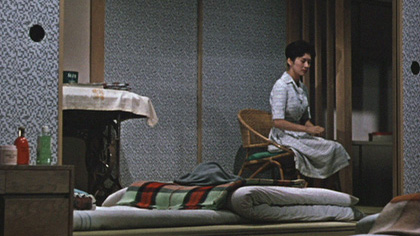
Late Autumn
A western viewer coming to Ozu films for the first time in the 21st century has to make two imaginative leaps to get the measure of them. First, we have to grasp that he worked in a system which no longer exists, unknown nowadays to both film-makers and filmgoers: he was a company employee all his life. He joined Shochiku in 1923 as an assistant cameraman (he was 19 at the time) and worked for it right up to his death from cancer on his 60th birthday. This meant not only steady employment for four decades, but also continuous access to all the resources of the company’s studios, including collaborations with writers, cinematographers, editors, designers and, of course, actors, all of whom were also contracted Shochiku staff. (Stars sometimes appeared ‘on loan’ from other companies until spring 1962, not long before Ozu’s death, when the majors nixed such deals as they scrabbled for ways to keep the mass audience from defecting to television.) The apparent consistency of the post-war films surely owes as much to this production situation as to Ozu’s aesthetic choices.
Second, we need to get past the presumption, eagerly fostered by many of Ozu’s compatriots themselves, that to be Japanese is to be unknowably different from everyone else in the world. In short, we need to put Ozu back into one context while extricating him from another – or, since ‘extricating’ is clearly impossible, then at least demystifying his Japaneseness. Obviously Ozu worked in a specific, volatile cultural-political-economic context, and equally obviously that context bore on his work in countless ways. Still, there’s hardly anything in the sociological background to Ozu’s films that lacks parallels in western countries, whether it’s in a tragi-comic account of joblessness in the Depression (Tokyo Chorus, 1931) or in a droll story of a harried suburban salaryman under pressure to keep up with the neighbours by buying a television set (Good Morning, 1959). What’s harder to get around is the sense that there’s something ineffable – something profoundly Buddhist, per Paul Schrader – in Ozu’s stubborn commitment to his particular angle of approach to family issues and his singular manner of storytelling. Is this something uniquely Japanese? Precise formalist analyses of the films by Kristin Thompson (her chapter on Late Spring in her 1988 book Breaking the Glass Armor) and David Bordwell (his 1988 book Ozu and the Poetics of Cinema, sadly out of print but readable online at www.davidbordwell.net) suggest that it isn’t.
From movie fan to movie man
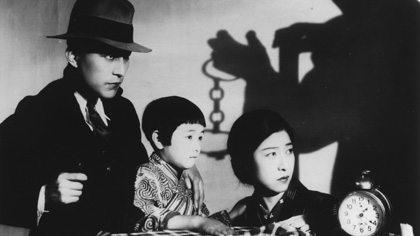
That Night’s Wife
Ozu was born in 1903 into a once-prosperous middle-class family (his father sold fertiliser in Fukugawa, an old working-class district of Tokyo which was levelled in the 1923 earthquake) and spent his teenage years with his mother and siblings in Matsuzaka, a once-fortified town near Nagoya. Unlike his elder and younger brothers, he was not cut out to be an academic achiever; he skipped the entrance exam for Kobe Higher Commercial School because he was watching an early version of The Prisoner of Zenda at the time.
In fact, Ozu the teenager was an archetypal movie brat. He frequently played truant to go to the Atago-za and Mino-za, cinemas in Matsuzaka; he collected film memorabilia; he wrote fan letters to benshi (the in-house narrator-performers who read out the intertitles and amplified the action), and he had good recall of everything he saw, down to some individual cuts and dissolves. He mostly saw Hollywood and other imported movies, which outnumbered Japanese films on local screens by nearly three to one; he was already reading plenty of modern Japanese fiction, but didn’t bother with local films. His indifference to the early output of Nikkatsu and Shochiku may have been partly related to the absence of onscreen women (female roles were played by onnagata until 1921); Ozu’s heterosexual impulses found an outlet in collecting bromides of his favourite stage actress Amatsu Otome. His homosexual impulses, meanwhile, got him expelled from the dormitory of his high school when his love letter to a junior boy was exposed; the incident rankled all his life, since he refused to attend a post-war high-school reunion when he learned that the teacher responsible for expelling him would be present.
In 1923, after a short stint as a teacher in a remote mountain village, he returned to Tokyo and got the job with Shochiku thanks to a recommendation from his uncle, a friend of the company manager. Ozu’s father strongly disapproved, but was eventually persuaded by his brother to allow the boy to work in films. Yasujiro’s cinephilia was lifelong, as witnessed by the ubiquity of Hollywood film posters in the dressing of his sets.
Ozu’s personal history had next to no visible impact on the films he made, although it’s true that the central characters in his films grew older as he did, and that the two times he traded up in the housing market (in the mid-1930s and early 1950s) may have had some oblique influence on his choices of stories and settings. But Ozu never went to university, and so his early student comedies were not drawn from life. He had no criminal record, and it’s safe to assume that his gangster movies did not spring from first-hand association with known felons. Most obviously, although he was one of five children (the second of three sons), he never married or had children of his own – and so his many ‘home dramas’ dealing with the emotional intricacies of parent-child relationships had no directly autobiographical roots.
Conversely, although Ozu’s early career was several times interrupted for weeks of training in the army reserves, and although he was twice drafted to serve in the army itself (first in occupied China in 1937, then in occupied Singapore in 1943), he never made a film featuring serving soldiers or army life. The only soldiers who ‘appear’ in his films are dead ones, mourned by their young widows. Early Summer (Bakushû, literally ‘Wheat Harvest Season’, 1951), Ozu’s only real metaphysical film, ends with a lateral tracking shot symbolising a funeral, with countless ears of wheat representing the transmigrating souls of the dead – particularly the lost son of the film’s Mamiya family, Shoji, mourned by the sister whose marriage he brokered and by their elderly parents.
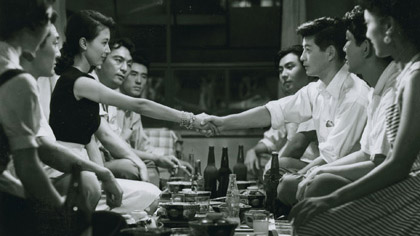
Early Spring
But knowing a little of Ozu’s life story helps us to understand aspects of his personality. Like most kids born in the Meiji Era (1868-1912, the years that saw Japan opening after some 260 years of feudal isolation), he was hungry for novelty – and found it, clearly, in the foreign movies he watched at every opportunity. He had standard boy’s-own tastes at the time – Pearl White cliffhanger serials, William S. Hart Westerns – but soon became aware of D.W. Griffith as a director, before moving on in the 1920s to admire and learn from Harold Lloyd, Lubitsch, von Sternberg and Borzage. (But his first loves lingered: William S. Hart is name-checked decades later in Late Spring, 1949.)
His youthful delinquencies mellowed into an abiding reluctance to submit to ‘authority’: the child who forged his mother’s household seal to help cover up illicit cinemagoing was father to the man who called himself a “stubborn old buzzard”, held out against using colour stock until 1958 and adamantly refused to shoot in CinemaScope. But Ozu retained his enthusiasm for most aspects of the modern world – an enthusiasm which was no doubt sharpened by having been forced to spend ten of his formative years away from Tokyo, and which perhaps explains his indifference to the Japanese films of the 1910s, most of which were historical pictures derived from the kabuki stage, redolent of ‘old’ Japan. That indifference is the flipside of his faintly bizarre enthusiasm for gasometers, factory chimneys and railways, shown in film after film.
Made fast and cheap, the early genre movies are consistently engaging and entertaining – and deeply indebted to American models, even though they contain plenty of Ozu’s ‘tofu’. The student slackers in Days of Youth (1929), I Flunked, But… (1930) and the opening scenes of Tokyo Chorus (1931) have seen films like Harold Lloyd’s The Freshman (1925) and Borzage’s 7th Heaven (1927), and amuse themselves copying the ‘western’ behaviour they’ve seen on screen; their digs are cluttered with American movie posters and assorted signs and symbols of American college life. The petty gangsters in Walk Cheerfully (1930) and Dragnet Girl (1933) and the edgy cops in That Night’s Wife (1930) are similarly Americanised; Walk Cheerfully is positively un-Japanese in its costumes, settings and behavioural tics, while Dragnet Girl revels in the sense of cosmopolitan modernity connoted by that most macho of imports from the US, the boxing gym.
Ozu knocked out these films and others like them (at least 16 are believed lost) very quickly, seven in 1930 alone, often in less than ten shooting days apiece. (Some of them, like the wonderful comedy A Straightforward Boy, 1929, recently retrieved from a private collection, were only three-reelers.) The furious rate of production would not have been possible without the support mechanisms of the system at Shochiku’s Kamata studio (where company boss Kido Shiro had brought in Hollywood-style rationalisation, with a script department, an editing department and so on), or without Ozu’s reliance on his batsu of male buddies – the group of crew members, fellow directors and other studio personnel with whom he went drinking to discuss movies. (The batsu included director Shimizu Hiroshi, who first came up with the idea for Walk Cheerfully.)
But the ‘tofu’ in the films was Ozu’s own. It’s partly found in the proliferating visual and verbal gags, usually credited to the imaginary ‘James Maki’, who was said to combine “the smartness of his American father and the delicacy of his Japanese mother”. Even more crucially, though, it’s found in the escalating experiments with composition, continuity links and film syntax, which gradually supersede Hollywood-style staging and cutting in the films of the early 1930s.
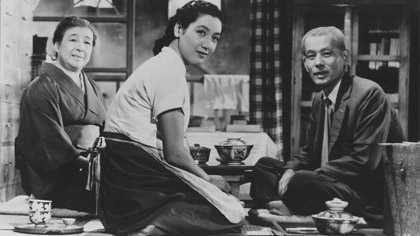
Tokyo Story
By the mid-1930s, when Ozu reluctantly started making talkies and wholeheartedly embraced the ‘home drama’ genre which would dominate the rest of his career, most of the tenets of his unique manner of storytelling were in place. Famously, he began using an unusually low camera position to show his characters and the spaces they inhabit, sometimes with a prominent object in the foreground; his cameraman Atsuta Yuharu explains in Wim Wenders’ frequently wretched essay-film Tokyo-ga (1985) that achieving this sometimes involved digging holes for the camera placement. Equally famously, Ozu did away with the eyeline matches of Hollywood reverse angles and developed his own method of cutting between people based on their shape and position within the frame. He replaced the fade-outs which had conventionally marked the ends of scenes with cutaway shots of locales and apparently extraneous objects, often to teasingly ambiguous effect. He constructed his scripts with patterns of repetition and variation, playing with audience expectations and challenging the viewer to notice tiny differences. There is, of course, much more to say about Ozu’s stylistic choices, but it’s worth stressing that these and his other tropes of ‘style’ are generally playful in spirit. The gags of the silent comedies have modulated into a humorously overt form of narration which is in perfect synch with Ozu’s wry view of his characters’ lives.
Thematically, Ozu finds most humour in the human capacity for misunderstanding: the mutual incomprehension between husband and wife in The Flavour of Green Tea over Rice (1952), the father’s wrong-headed estimation of his own authority in Equinox Flower (1958). Even in the silent comedies, though, the humour co-existed with pathos and melancholy, and the underlying sense of life’s disappointments comes to the surface in several films, both pre-war and post-war. Many critics have been baffled by Ozu’s insistence that Tokyo Story, often considered his masterpiece, was “too melodramatic”; what he surely meant was that the script construction was too schematic and insufficiently leavened with the characteristic play with visual patterning which lightens many of his other films. However, Tokyo Story stands up well as both social satire (the caricatures of bitchy, petty-bourgeois in-laws) and social commentary (the hints of the new delinquency that disrupt the elderly parents’ visit to the Atami hot springs). The story hinges on a decay in the bonds that united families before the war; hence the nostalgic tone and the relative absence of humour.
Ryu Chishu, who appeared in almost everything Ozu made, played the bereaved patriarch in Tokyo Story and took a very similar role in Ozu’s last film An Autumn Afternoon (1962): another widower, this time destined to be left on his own once his feisty daughter finally accepts a marriage proposal. Some see Ryu as a surrogate for Ozu himself and take his forlorn final scenes as a kind of valediction – as if Ozu knew that he was terminally ill when he made the film. (He didn’t.) Actually, though, the film focuses more on the daughter than the father, and Iwashita Shima’s sparky performance suggests that Ozu was ready to tackle a character as ‘modern’ as some of his 1930s heroines. The tofu was still fresh.
An Ozu retrospective plays at BFI Southbank, London until 27 February
Artist of the Floating World: Alexander Jacoby on Mizoguchi Kenji (April 2008)
In the realm of Oshima: Alexander Jacoby on Oshima Nagisa (September 2009)
Five (aka Five Long Takes Dedicated to Yasujiro Ozu) reviewed by Jonathan Romney (June 2005)